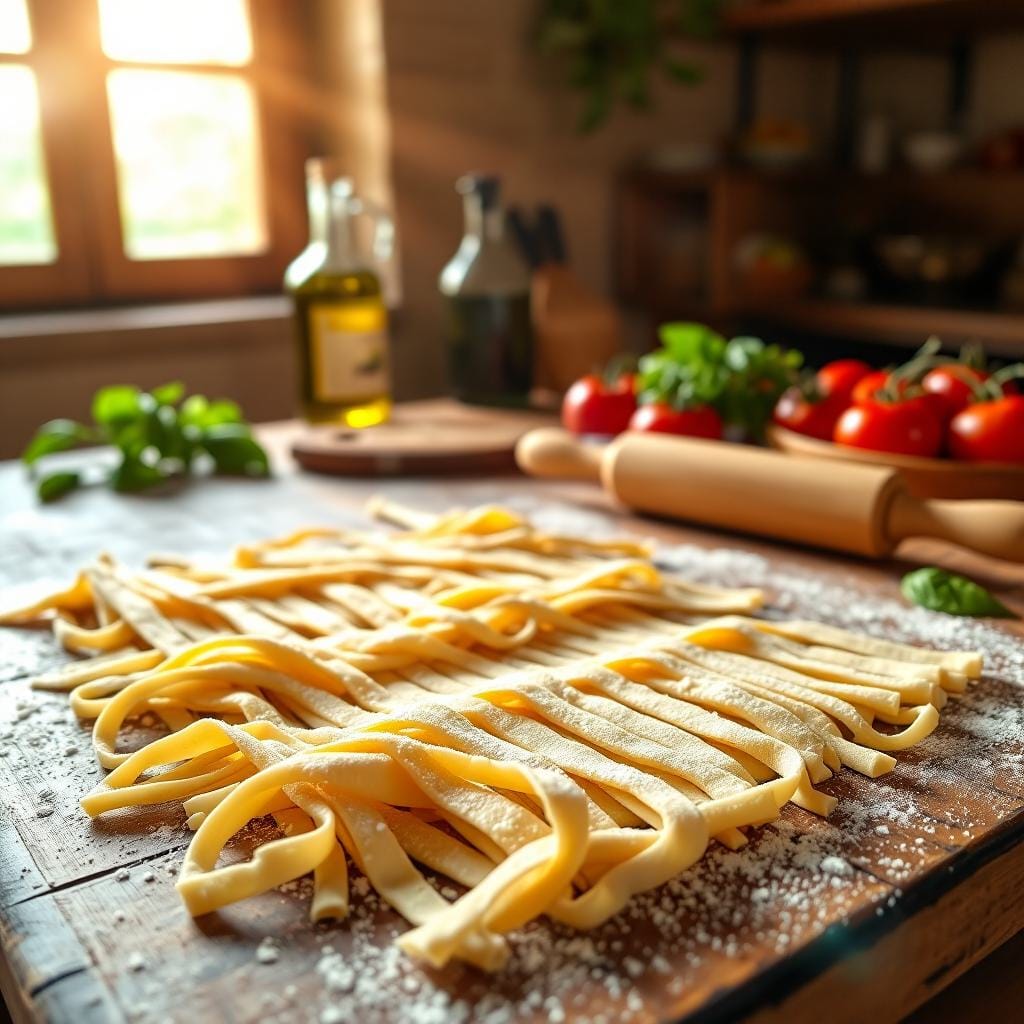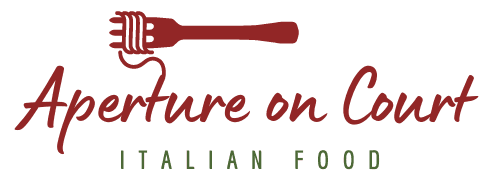Jump to Recipe
Imagine walking through the sun-kissed streets of Umbria, where every corner hides a secret and every family has a recipe they love. This is where the famous Umbrian dish strangozzi really shines. I remember the first time I made this pasta at home. Putting my hands into the dough, just like people have done for generations, gives me an unmatched sense of simple but deep joy.
Strangozzi is more than just pasta; it’s a link to the heart of classic Italian cooking. Because it’s thick and chewy, it reminds me of simpler times when cooking was a daily treat. I can still picture my grandmother carefully rolling out the dough while telling stories. The smell of flour and olive oil mixed with her voice.
I can share a piece of Italian cooking history with you by making this strangozzi pasta. It’s not just a meal; it’s a journey through Italian food traditions that brings Italy to our homes. I promise that as we work through this recipe, you’ll feel the same warmth and connection to this beloved pasta.
The History and Origin of Strangozzi
If you look into the history of pasta, you’ll find that Strangozzi’s roots go deep into Italian food. This thick-cut pasta comes from Umbria and represents hundreds of years of food culture there. In history, strangozzi has been a sign of strength and tradition, and it shows how rich the region’s culinary history is.
Strangozzi was first used in the Middle Ages and got its name from looking like shoelaces. Back then, it was usually made by families in the area with simple ingredients found in the area. By bringing attention to these local stories, we can really understand its place among Umbrian specialties.
As I learn more about Strangozzi’s past, I find not only a dish but also proof of how Italian food has had a huge impact on people all over the world. This pasta is like a link between traditional Umbrian flavors and modern kitchens all over the world.
I think of the long history of strangozzi and the traditions of Umbrian food culture every time I eat it. Each bite is a tasty trip through time that honors one of Italy’s most beloved regional specialties.
Ingredients Needed for Strangozzi
It’s important to have a few key ingredients when making strangozzi. These will help you make sure that the traditional Umbrian pasta has the right texture and flavor. You can also change the recipe to your liking by adding some optional ingredients.
Essential Ingredients
You need a few basic pasta ingredients that are at the heart of Italian cooking to make Strangozzi. Some of these are:
- High-quality flour: Type “00” flour is traditionally preferred for its fine texture.
- Water: Use precise measurements to ensure the dough consistency is just right.
These are the main ingredients that make up your strangozzi. Getting them to work together well is the key to making a tasty, authentic dish.
Optional Additions
If you want to make the recipe a little more your own, try adding these things. They could be in your kitchen pantry right now:
- Pinch of salt: it enhances the flavor subtly yet effectively.
- Drizzle of olive oil: adds a richer taste and a smoother texture.
By trying these extras, you can make the dish better and make it your own. Now that you have these basic Italian cooking tools, you’re ready to learn how to make your own pasta.

Step-by-Step Guide to Making Strangozzi
It’s fun and educational to make strangozzi at home. You can follow this guide to making your own pasta step by step. You’ll get good at making pasta quickly if you follow these steps. Making Italian food at home is fun and easy.
Preparing the Dough
First, put the flour on a clean surface by sifting it. Make a hole in the middle and put the eggs in it. Pour some olive oil and a pinch of salt over the food. Slowly mix the flour into the eggs with your fingers until you get a rough dough.
For about 10 minutes, knead the dough very hard. It needs to get smooth and stretchy. If it’s too sticky, add more flour. If it’s too dry, add a few drops of water. This part is very important in any cooking book because it explains how to knead dough the right way.
Rolling and Cutting the Pasta
After letting the dough rest for at least 30 minutes, cut it up into smaller pieces. Use a rolling pin or a pasta machine to make each piece thinner on a floured surface. Try to make it about 1/8 inch thick.
Next, make long, thick strips of dough that are about 1/4 inch wide. This is what makes strangozzi different from other kinds of pasta. Do it yourself Italian food is all about adding your own touch, so don’t worry if some of the food isn’t perfect.
Make a floured sheet and spread out the cut pasta. Let it dry for about 15 minutes before cooking. If you follow these steps for making homemade strangozzi, they will have the right texture and taste.
Tasty Sauces to Pair with Strangozzi
There are a lot of different Italian sauces that can make your strangozzi taste better. Let’s look at some traditional Umbrian sauces and some newer versions that are sure to make your taste buds happy and leave you wanting more.
First, we have the traditional black truffle sauce from Umbria. It goes well with strangozzi because it has a rich and earthy flavor that brings out the pasta’s unique texture. Black truffles, olive oil, garlic, and a little parsley are mixed together to make this simple but rich sauce.
People have loved the pomodoro and basil sauce for a long time. This colorful tomato-based choice is often used in pasta sauce recipes. It packs a bright, acidic punch that goes well with strangozzi’s thicker cut. It tastes great when you mix fresh basil, ripe tomatoes, and a little garlic.
Try a wild boar ragù if you want something a little heartier. The flavors of Umbria come through in this sauce, which is slowly cooked with red wine, tomatoes, and fragrant herbs. If you want a rich and savory experience, you have to try it.
Think about a lemon butter sage sauce for a modern twist. The tangy lemon and earthy sage go well with the pasta and make a fresh, light alternative to sauces that are heavier. It’s perfect for showing off how springy strangozzi is.
Here’s a simple recipe to start with:
- Put butter and olive oil in a pan and heat them over medium heat.
- Put in some lemon zest and fresh sage leaves.
- While cooking, add the cooked strangozzi and stir them in.
If you try these pasta sauce recipes, your meals will become real culinary treats. The right sauce will definitely make your strangozzi experience better, no matter if you stick to traditional Umbrian sauces or try something new.

Strangozzi Pasta
Ingredients
Method
- Prepare the Dough:
- Sift the flour onto a clean surface, making a well in the center. Gradually add water, mixing it into the flour with your hands until it forms a rough dough. Optional: Add a pinch of salt or olive oil for more flavor.
- Knead the Dough:
- Knead the dough for about 10 minutes until it becomes smooth and elastic. If it's too sticky, add a little more flour. If it's too dry, add a few drops of water.
- Let it Rest:
- Cover the dough with a damp cloth and let it rest for at least 30 minutes.
- Roll Out the Dough:
- Divide the dough into smaller pieces. Roll each piece out on a floured surface to about 1/8 inch thick.
- Cut the Pasta:
- Slice the dough into long strips about ¼ inch wide. Lay them out on a floured sheet to dry slightly for 15 minutes before cooking.
- Cook the Strangozzi:
- Boil the pasta in salted water for 6-8 minutes until it’s tender but still has some bite (al dente). Drain and serve with your favorite sauce.
Notes
If you don't have "00" flour, all-purpose flour will work in a pinch, though the texture may vary.
Serving and Enjoying Strangozzi
As soon as you know how to make strangozzi perfectly, it’s time to serve and enjoy this tasty pasta. One important part of Italian dining is not only the food, but also the atmosphere you create. Here are some ideas for how to serve and present your food so that it tastes truly authentic.
I recommend using rough, earthy dinnerware when serving strangozzi. It goes well with the heartiness of the pasta and makes it look better. Before you serve the pasta, you might want to drizzle a little good olive oil over it. It gives it a rich finish that goes well with all the other flavors.
If you want to make your meal truly Italian, try eating your strangozzi with a fresh, crisp salad. Add some mixed greens to a simple salad to make the meal less heavy.
Don’t forget an Italian loaf of bread with a crust that you can use to soak up any sauce that’s left over. A glass of strong Italian red wine, like Chianti, can make the whole meal better.
FAQ
What is strangozzi, and why is it significant in Umbrian cuisine?
The thick, chewy pasta called strangozzi is a classic dish from Umbria. Because of its shape and texture, it soaks up hearty sauces very well, bringing out the rich, rustic flavors of Central Italy’s traditional food. When you make your own strangozzi, you feel like you’re in Italy without leaving your kitchen.
Where does strangozzi originate from?
Strangozzi is from Umbria, which is in the middle of Italy and has beautiful scenery. This pasta is a symbol of the simplicity and depth of Umbrian food culture. It has been a mainstay of Italian cuisine for hundreds of years and represents the region’s rich culinary history.
What are the essential ingredients needed to make strangozzi?
Good flour and water are the two most important things you need to make strangozzi. Making the dough’s structure and giving it the right texture and consistency are these two things.
Are there any optional additions that can enhance the strangozzi recipe?
Of course! A pinch of salt or a drizzle of olive oil can make homemade pasta taste better if you want to add your own style to it. You can be as creative as you want with what you have in your kitchen pantry.
How do I prepare the dough for strangozzi?
To make the dough, mix sufficient flour with water until the mixture is smooth and stretchy. Work the dough hard, let it rest, and then roll it out to the thickness you want.
What are the best techniques for rolling and cutting the pasta?
On a floured surface, roll out the dough until it is the right thickness. Strangozzi are made with thick strips, which you should aim for when you cut. It takes practice to get good at it, but once you do, it’s really fun.
Which sauces pair well with strangozzi?
A lot of different sauces go well with strangozzi. The earthy taste of the pasta comes out in traditional Umbrian sauces like a hearty tomato-based sauce or a rich meat ragu. Try putting together different flavors to find your favorite!
How should I serve and enjoy strangozzi for an authentic Italian meal?
To serve real strangozzi, do it the way the Italians do it: with love and care. With your pasta, enjoy a fresh side salad, some rustic bread, and a good glass of wine. Set up a warm and welcoming space to really enjoy this delicious food.
